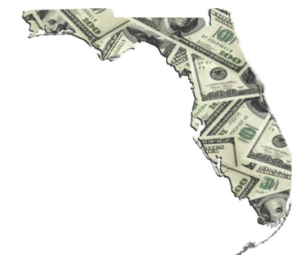By John Haughey
The Center Square
August 30, 2019
 State economists estimate Florida will collect about $867 million less in revenue over the next two years than they projected in March.
State economists estimate Florida will collect about $867 million less in revenue over the next two years than they projected in March.
The Revenue Estimating Conference’s updated General Revenue Fund & Financial Outlook Statement reduces the state’s March 2019 revenue estimate by $451.6 million for this year and by $416.1 million for Fiscal Year 2021.
The reduction was anticipated but had not been formerly incorporated into revenue projections, which are updated about twice a year by the conference, comprised of fiscal analysts from state agencies and the Legislature’s Office of Economic & Demographic Research (OEDR).
The estimates crafted by the Revenue Estimating Conference and maintained by the OEDR on its website will be used by the governor’s office to develop its Fiscal Year 2021 budget request and by lawmakers when they convene their 60-day 2020 session on Jan. 14.
The primary reasons cited by the conference for the downward adjustment is the suspended revenue-sharing compact with the Seminole Tribe and changes adopted by the Republican-controlled Legislature in 2018 and 2019 following the adoption of the federal 2017 Tax Cuts & Job Act (TCJA).
The Legislature failed to secure an agreement with the Seminoles, which have discontinued making their annual payments until they resolve differences with the state in a dispute over gambling at race tracks.
The tribe made its last monthly payment in April. Until a new compact is secured, the state will lose $346.7 million this year in revenue and $360.5 million in fiscal year 2021, according the conference.
According to the outlook, “The estimated combined effects of legislation passed during the 2018 and 2019 sessions to lower the corporate income tax offset expected increased collections as a result of federal law changes [the TCJA] by slightly over $1.1 billion this year and $704.5 million in fiscal year 2021.”
Among those “combined effects” is a measure adopted by lawmakers during the 2019 legislative session to cap corporate tax revenue at no more than 7 percent above what state economists had projected in corporate tax revenues before the adoption of the TCJA.
Factoring in those revisions, the revised fiscal year 2020 estimate “falls below the prior year’s collections by slightly over $470 million – 1.4 percent – and the revised forecast for Fiscal Year 2021 “has projected growth of slightly over $1.4 billion – or 4.3 percent – over the revised FY 2020 estimate.”
Those projected revenue declines are mitigated somewhat by projected increases in sales tax revenues – the state’s biggest source of income – and in forecast increases in insurance premium taxes, beverage and liquor licenses, real estate transactions and corporate filing fees.
State revenue collections, according to the outlook, are actually above monthly estimates by a combined $507.2 million over 2018’s revenues.
Nearly 76 percent of the gain was related to the state’s 5.5 percent corporate income tax receipts – even with the 7 percent cap for many of the state’s largest corporations – as the state’s small business base continues to grow.
Other factors “influencing the estimates were the upward adjustment in the current year to sales tax and in both years to insurance taxes,” according to the outlook.
While a slowing national economy could foster further “revenue adjustments,” the outlook maintains the state’s overall economy remains strong.
That assessment is bolstered by a sustained increase in jobs with more than 10 million Floridians employed.
Jobs continued to be added at a 2.8 percent rate in July while the state’s unemployment rate declined from 3.4 percent to 3.3 percent, below the national average of 3.7 percent.
The state’s biggest industry, tourism, continues to boom with a record-high 68.9 million tourists visiting the state in the first half of the year.
In early August, Florida Realtors announced single-family home sales were up 10.4 percent in July compared to July 2018.
